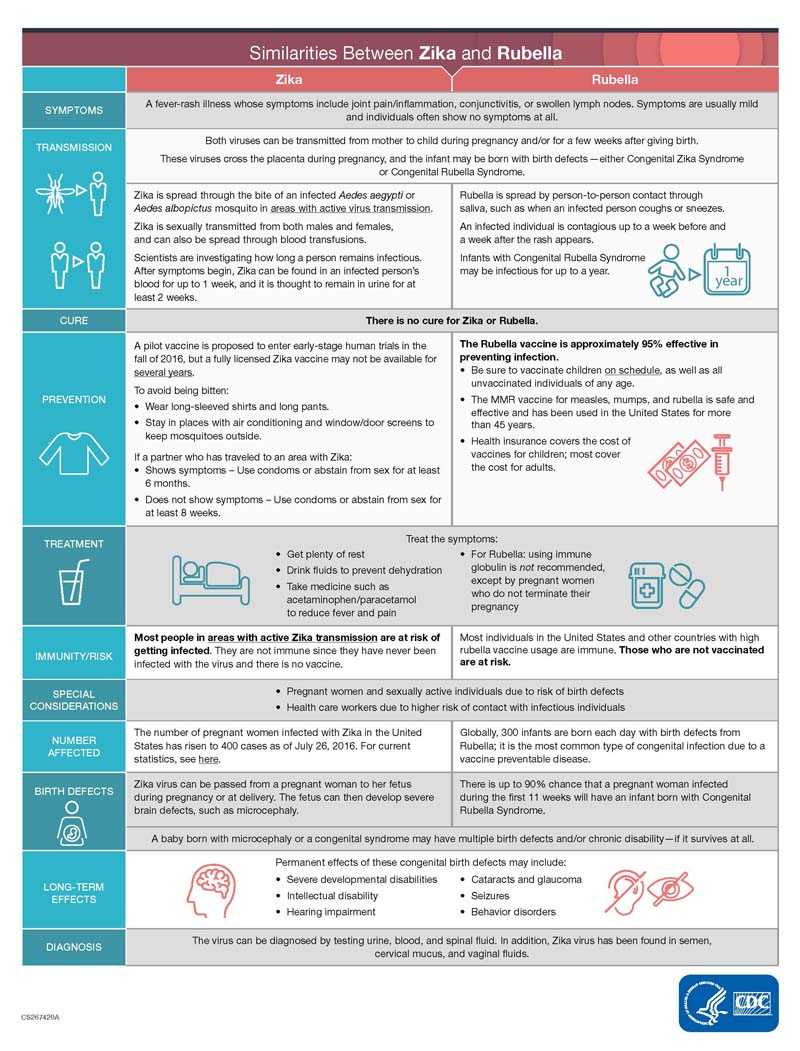Similarities between Zika and Rubella
Description of Infographic
Similarities between Zika and Rubella
Symptoms
A fever-rash illness whose symptoms include joint pain/inflammation, conjunctivitis, or swollen lymph nodes. Symptoms are usually mild and individuals often show no symptoms at all.
Transmission
Both viruses can be transmitted from mother to child during pregnancy and/or for a few weeks after giving birth. These viruses cross the placenta during pregnancy, and the infant may be born with birth defects — either Congenital Zika Syndrome or Congenital Rubella Syndrome.
Zika:
Zika is spread through the bite of an infected Aedes aegypti or Aedes albopictus mosquito in areas with active virus transmission. Zika is sexually transmitted from both males and females, and can also be spread through blood transfusions.
Rubella:
Rubella is spread by person-to-person contact through saliva, such as when an infected person coughs or sneezes. An infected individual is contagious up to a week before and a week after the rash appears. Infants with Congenital Rubella Syndrome may be infectious for up to a year.
Cure
There is no cure for Zika or Rubella
Prevention
Zika:
A pilot vaccine is proposed to enter early-stage human trials in the fall of 2016, but a fully licensed Zika vaccine may not be available for several years.
To avoid being bitten:
- Wear long-sleeved shirts and long pants.
- Stay in places with air conditioning and window/door screens to keep mosquitoes outside.
If a partner who has traveled to an area with Zika:
- Shows symptoms – Use condoms or abstain from sex for at least 6 months.
- Does not show symptoms – Use condoms or abstain from sex for at least 8 weeks.
Rubella:
The Rubella vaccine is approximately 95% effective in preventing infection.
- Be sure to vaccinate children on schedule, as well as all unvaccinated individuals of any age.
- The MMR vaccine for measles, mumps, and rubella is safe and effective and has been used in the United States for more than 45 years.
- Health insurance covers the cost of vaccines for children; most cover the cost for adults.
Treatment
Treat the symptoms:
- Get plenty of rest
- Drink fluids to prevent dehydration
- Take medicine such as acetaminophen/paracetamol to reduce fever and pain
For Rubella: immune globulin is not recommended except for exposed pregnant women who elect not to terminate the pregnancy.
Immunity/risk
Zika:
Most people in areas with active Zika transmission are at risk of getting infected. They are not immune since they have never been infected with the virus and there is no vaccine.
Rubella:
Most individuals in the United States and other countries with high rubella vaccine usage are immune. Those who are not vaccinated are at risk.
Special Considerations
- Pregnant women and sexually active individuals due to risk of birth defects
- Health care workers due to higher risk of contact with infectious individuals.
Number Affected
Zika:
The number of pregnant women infected with Zika in the United States has risen to 400 cases as of July 26, 2016. For current statistics, see here.
Rubella:
Globally, 300 infants are born each day with birth defects from Rubella; it is the most common type of congenital infection due to a vaccine preventable disease.
Birth Defects
A baby born with microcephaly or a congenital syndrome may have multiple birth defects and/or chronic disability—if it survives at all.
Zika:
Zika virus can be passed from a pregnant woman to her fetus during pregnancy or at delivery. The fetus can then develop severe brain defects, such as microcephaly.
Rubella:
There is up to 90% chance that a pregnant woman infected during the first 11 weeks will have an infant born with Congenital Rubella Syndrome.
Long-term effects
Permanent effects of these congenital birth defects may include:
- Severe developmental disabilities
- Intellectual disability
- Hearing impairment
- Cataracts and glaucoma
- Seizures
- Behavior disorders
Diagnosis
The virus can be diagnosed by testing urine, blood, and spinal fluid. In addition, Zika virus has been found in semen, cervical mucus, and vaginal fluids.
- Page last reviewed: August 5, 2016
- Page last updated: August 5, 2016
- Content source:
Global Health
Notice: Linking to a non-federal site does not constitute an endorsement by HHS, CDC or any of its employees of the sponsors or the information and products presented on the site.


 ShareCompartir
ShareCompartir
